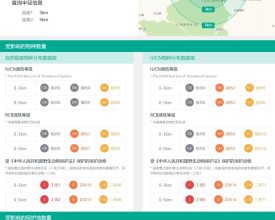
China Nature Watch: uso de la tecnología para la recopilación y aplicación de información sobre biodiversidad con el fin de facilitar la toma de decisiones respetuosas con la biodiversidad.

Los datos de referencia sobre biodiversidad son fundamentales para la toma de decisiones y las prácticas de conservación, pero se enfrentan a la deficiencia de datos y la asimetría de la información. Con la ayuda de herramientas tecnológicas, China Nature Watch pretende reforzar la recopilación de datos sobre biodiversidad procedentes de diversas fuentes, especialmente la ciencia ciudadana, facilitar la aplicación de los datos en la planificación del uso del suelo y la participación pública, e integrar la conservación de la biodiversidad.
En concreto, la tecnología aporta soluciones eficaces a 3 módulos:
- Gestión de datos de cámaras trampa: desarrollo de un sistema de gestión de datos en línea con inteligencia artificial para simplificar y acelerar la recogida y el procesamiento de datos de cámaras trampa.
- Visualización de datos de ciencia ciudadana: uso de PowerBI para analizar automáticamente y visualizar de forma interactiva los registros de especies recogidos por científicos ciudadanos.
- Herramienta de evaluación del impacto en la biodiversidad (BiA): integración de datos ecológicos y de construcción de múltiples fuentes de datos para ofrecer una consulta instantánea de la evaluación del impacto en la biodiversidad de los proyectos de construcción a través de una plataforma en la nube.
Contexto
Défis à relever
Todos los procesos del flujo de trabajo de los datos de biodiversidad, desde la recopilación, el procesamiento y la visualización hasta la aplicación, son engorrosos y tediosos, requieren mucho trabajo repetitivo y necesitan simplificarse y automatizarse urgentemente.
- Gestión de datos de cámaras trampa: el seguimiento comunitario con cámaras trampa se enfrenta a cuellos de botella de baja eficiencia (por ejemplo, recogida de datos de monitores comunitarios locales, identificación manual de especies) y calidad de datos inestable y relativamente baja (por ejemplo, datos incorrectos y faltantes, altos índices de fotos en blanco).
- Visualización de datos de ciencia ciudadana: los productos de visualización son estáticos y específicos de cada campaña, creados manualmente en varias etapas de cada campaña, lo que cuesta mucho esfuerzo a los conservacionistas y sólo proporciona retroalimentación tardía a los científicos ciudadanos.
- Evaluación del impacto en la biodiversidad: la escasez de datos y la falta de acceso público a los mismos han limitado los escenarios de uso de los datos. Además, la evaluación del impacto en la biodiversidad se realiza manualmente para cada investigación, y los informes se elaboran manualmente.
Ubicación
Procesar
Resumen del proceso
La planificación general y el desarrollo de una asociación de apoyo han proporcionado una base concreta para el proyecto.
Los datos de las cámaras trampa son una fuente integral de distribución de especies para la base de datos de Nature Watch. El sistema de gestión de datos de cámaras trampa acelera el flujo de trabajo general y mejora la introducción puntual de datos de cámaras trampa en la base de datos. Al igual que los datos de los científicos ciudadanos, como otra fuente de registro de especies, la plataforma de visualización ayuda a inspirar el entusiasmo de los científicos ciudadanos y a impulsar las observaciones de especies. Ambos componentes básicos acumulan datos para la herramienta BiA, promoviendo una evaluación más precisa.
Además, la plataforma de visualización y la herramienta BiA implican la comunicación pública dirigida a diferentes audiencias, complementándose mutuamente para el objetivo final de la integración de la biodiversidad.
Bloques de construcción
Análisis del flujo de trabajo, creación de asociaciones y planificación general
Años de investigación y prácticas de conservación no sólo han puesto de relieve la importancia de los datos sobre biodiversidad, sino que también han revelado los defectos del flujo de trabajo actual, que van desde una gestión ineficiente de los datos, pasando por la falta de integración de los mismos, hasta la escasez de aplicaciones de datos accesibles al público. Además, este flujo de trabajo se basa principalmente en la mano del hombre y a menudo implica mucho trabajo repetitivo, lo que consume una enorme cantidad de tiempo de los conservacionistas.
Con el rápido desarrollo de la tecnología, nos hemos ido dando cuenta poco a poco de su potencial para aportar soluciones a nuestros "puntos débiles" durante mucho tiempo. Con el fin de utilizar las herramientas tecnológicas en los lugares más necesitados, se llevó a cabo una revisión y un análisis sistemáticos del flujo de trabajo actual para identificar los cuellos de botella con altas prioridades y las posibles soluciones. La contemplación comenzó en mayo de 2018 y se materializó a partir de junio de 2019 después de que surgieran posibles socios técnicos. Basándonos en el análisis sistemático del flujo de trabajo y en una estrecha colaboración, elaboramos un plan paso a paso, con el objetivo de desarrollar módulos uno a uno, teniendo en cuenta nuestros limitados recursos y mano de obra (por ejemplo, desde la app asistente de monitorización comunitaria de cámaras trampa, hasta la herramienta BiA, pasando por la plataforma de visualización de datos de ciencia ciudadana y el sistema de gestión de datos de cámaras trampa).
Factores facilitadores
- Una revisión sistemática del flujo de trabajo actual y un análisis de carencias que indique dónde pueden ayudar las herramientas tecnológicas.
- Socios técnicos fiables y que presten su apoyo (mediante ensayo y error)
- Un plan ambicioso pero práctico
Lección aprendida
- Involucrar a varios colegas en el debate sobre el flujo de trabajo y las soluciones técnicas es útil para recoger ideas más valiosas.
- Las distintas empresas técnicas tienen estilos de trabajo diferentes. Elige las que se adapten a tu estilo de trabajo y tus valores.
Sistema de gestión de datos de cámaras trampa
Para acelerar los flujos de trabajo de datos de las cámaras trampa, se está desarrollando, con el apoyo de socios técnicos, un sistema de gestión de datos en línea junto con herramientas basadas en aplicaciones y reconocimiento de imágenes mediante IA, que consiste en:
- Aplicación comunitaria de asistencia para el seguimiento de cámaras trampa: la aplicación permite a los monitores locales registrar automáticamente la hora y la ubicación GPS de la instalación/recogida de las cámaras trampa, lo que ahorra el engorroso proceso de recopilación de datos de los monitores locales y la introducción manual de datos. (proyecto: Jun 2019, desarrollo: Oct 2019-Feb 2020, prueba y uso: Mar-Oct 2020)
- Modelos de reconocimiento de imágenes de IA: Los modelos de IA ayudan a detectar animales e identificar especies en fotos de cámaras trampa, lo que reduce en gran medida el número de fotos que necesitan identificación humana y mejora la eficiencia del procesamiento de datos.
- Se ha entrenado y/o probado una serie de modelos de IA con socios técnicos, incluido el modelo PU & PKU ResNet18 (2018), MegaDetector (solo prueba, 2020), modelo MindSpore YOLOv3 (2021).
- Plataforma de gestión de datos en línea: la información de las cámaras trampa recopilada a través de la aplicación junto con las fotos se cargan en una base de datos estructurada en la nube. La plataforma de gestión de datos no solo permite la identificación de especies mediante IA y humanos, sino también la búsqueda global de datos y la elaboración de informes estadísticos. (proyecto: Abr-Ago 2021, desarrollo: Sept 2021-Jun 2022, prueba y uso: Jul 2022)
Factores facilitadores
- Una revisión sistemática del flujo de trabajo actual de los datos de cámaras trampa y su traducción en necesidades técnicas de desarrollo de sistemas.
- Modelos de reconocimiento de IA de imágenes de cámaras trampa de código abierto y buen rendimiento
- Recursos en la nube para computación de IA, almacenamiento de datos, etc.
- Rondas de pruebas y comentarios para corregir errores y mejorar la usabilidad del sistema.
Lección aprendida
- Roma no se construyó en un día. Debido a las limitaciones de tiempo y recursos, tenemos que dividir el sistema en distintos módulos y desarrollarlos paso a paso. Creemos que cada módulo por sí mismo puede mejorar uno o varios pasos de nuestro flujo de trabajo y nos hemos beneficiado de los módulos antes de incorporarlos al sistema completo. Sin embargo, es importante tener una perspectiva global al principio y hacer planes a largo plazo para la integración final del sistema.
- Un sistema no puede ser perfecto desde el principio. Cuando la aplicación se lanzó por primera vez y se puso en marcha en una comunidad, no funcionó como esperábamos y los monitores locales informaron de diversos tipos de fallos. Recogimos y analizamos los comentarios para mejorar el diseño de la interfaz de usuario y la funcionalidad de la aplicación.
Plataforma de visualización de datos de ciencia ciudadana
Durante las campañas de vigilancia de la naturaleza, se invita a los ciudadanos científicos a observar y registrar puntualmente la vida salvaje, lo que no sólo refuerza la conexión entre los ciudadanos y la naturaleza, sino que también sirve como prometedora fuente de datos sobre la distribución de especies. Los datos de registro de especies recogidos por los científicos ciudadanos a través del cuestionario en línea fluyen automáticamente a la base de datos de la plataforma de visualización (tras la limpieza de datos y la comprobación periódica manual) y se convierten en gráficos y mapas visualizados intuitivos y atractivos (de dos tipos: espacial, espacial y temporal) a través de Power BI. La plataforma, con versión web y móvil, proporciona información en tiempo real sobre los esfuerzos de vigilancia de la naturaleza de los científicos ciudadanos, lo que aumenta su sensación de logro y motiva su futura participación en actividades de vigilancia de la naturaleza. Además, dado que la plataforma integra múltiples campañas de observación de la naturaleza con enlaces a artículos web sobre análisis específicos de cada campaña, ofrece un amplio abanico de conocimientos sobre biodiversidad y permite la "observación virtual de la naturaleza" para que los ciudadanos conozcan la vida silvestre de otras regiones.
Breve cronograma de la plataforma:
- Ene-Feb 2021: formar equipo, analizar análisis, elaborar anteproyecto
- Mar-Jun 2021: desarrollo de la base de datos y la plataforma
- Julio-agosto de 2021: prueba de ensayo
- Septiembre de 2021: lanzamiento y promoción
Factores facilitadores
- Un cuestionario de recogida de datos bien diseñado y un mecanismo automático de limpieza de datos para garantizar la calidad de los mismos y una comprobación manual periódica (normalmente una vez por temporada) para garantizar la realidad de los datos.
- Selección de métodos de visualización y diseño estético con la participación de científicos ciudadanos.
- Tecnología PowerBI.
- Funcionamiento y mantenimiento de la comunidad WeChat de científicos ciudadanos.
Lección aprendida
- Como producto de divulgación pública, nunca está de más pulir los contenidos y el diseño estético para que la plataforma resulte fácil de usar y atractiva.
- Involucrar a los usuarios en la fase de planificación y recoger sus opiniones es muy útil para identificar sus necesidades.
- Es necesario que los cuestionarios estén bien diseñados y que los científicos ciudadanos estén bien formados antes de registrar los datos. De lo contrario, es fácil que se pierdan datos.
Herramienta de evaluación del impacto sobre la biodiversidad (BiA)
Con el fin de permitir la consulta automática e instantánea de la evaluación del impacto sobre la biodiversidad, se ha desarrollado la herramienta BiA para facilitar los servicios de consulta a los planificadores del territorio y otras partes interesadas a través de la plataforma Azure. La herramienta BiA funciona superponiendo el lugar o la región de la consulta (o los proyectos de construcción existentes) con múltiples capas geográficas que incluyen la distribución de especies y el área de distribución de zonas protegidas para investigar si el lugar o la región se encuentra a una distancia determinada (por ejemplo, 3 km, 5 km) y puede causar un impacto en el hábitat de especies en peligro de extinción y/o zonas protegidas. Los informes de evaluación ilustran los riesgos ecológicos y medioambientales de los proyectos de construcción para los responsables de la toma de decisiones y cabe esperar que les animen a tener en cuenta la biodiversidad.
Breve cronología de la herramienta BiA:
- Abr-Jun 2020: formación del equipo, comunicación de requisitos, plan de desarrollo del sistema
- Julio-septiembre de 2020: desarrollo de la herramienta
- Oct 2020: prueba de ensayo, aplicación y difusión
- (en preparación) Abr-Sep 2022: actualización del sistema
Factores facilitadores
- Años de acumulación de recopilación de datos y constante reflexión sobre los enfoques de aplicación de los datos.
- Base teórica y técnica acumulada a partir de la investigación a largo plazo y la práctica de la conservación.
- Promoción de la herramienta BiA entre sus usuarios potenciales, como gobiernos, inversores y empresas.
- Seguimiento del funcionamiento de la herramienta y de los comentarios de los usuarios para mejorarla.
Lección aprendida
- La aplicación de datos es el paso más importante de todo el flujo de trabajo de datos, en el que los datos se convierten en información valiosa para las partes interesadas. Los informes de aplicación de datos eficaces deben tener en cuenta a la audiencia (por ejemplo, ser concisos y centrados).
- Completar el desarrollo y la publicación no es el último paso de una herramienta. También es muy importante encontrar usuarios potenciales y convencerles de que utilicen la herramienta. Una herramienta tiene que utilizarse para aportar el máximo valor.
Impactos
Las soluciones tecnológicas han optimizado el flujo de trabajo de los datos sobre biodiversidad y fomentado su aplicación:
- Gestión de datos de cámaras trampa: La aplicación comunitaria de seguimiento de cámaras trampa ha facilitado el registro de datos a 86 monitores locales encargados de instalar y recoger las cámaras trampa sobre el terreno. Los modelos de reconocimiento de imágenes de IA han procesado más de 380.000 imágenes de cámaras trampa, sustituyendo más de 100 horas de trabajo. Esta aceleración en la recopilación y el procesamiento de datos permite informar a tiempo a las partes interesadas y contribuye a la toma de decisiones en materia de conservación.
- Visualización de datos de ciencia ciudadana: Mediante la visualización de 2688 registros de 22 especies recogidos durante seis campañas en 2016-2021 y la actualización automática de los nuevos registros recogidos, la plataforma ha proporcionado retroalimentación espacial, temporal e interactiva a los participantes de la ciencia ciudadana y ha impulsado significativamente el interés en las actividades de observación de la naturaleza.
- Herramienta BiA: La base de datos Nature Watch mantiene datos de referencia sobre biodiversidad recogidos de múltiples fuentes de datos, incluidos registros de especies (2591 especies, 1,35 millones de registros) y áreas protegidas (6 parques nacionales, 474 áreas protegidas nacionales, etc.). Hasta ahora, la herramienta BiA ha proporcionado servicios de consulta interactivos y visualizados de evaluación del impacto en la biodiversidad a más de 1260 planificadores de proyectos de construcción y otras partes interesadas, facilitando la toma de decisiones respetuosas con la biodiversidad.
Beneficiarios
- Conservacionistas: mayor eficacia
- Comunidades locales: mayor eficacia e información oportuna
- Ciudadanos científicos: información oportuna
- Agencias gubernamentales, instituciones académicas, público: fácil acceso a los datos sobre biodiversidad






















